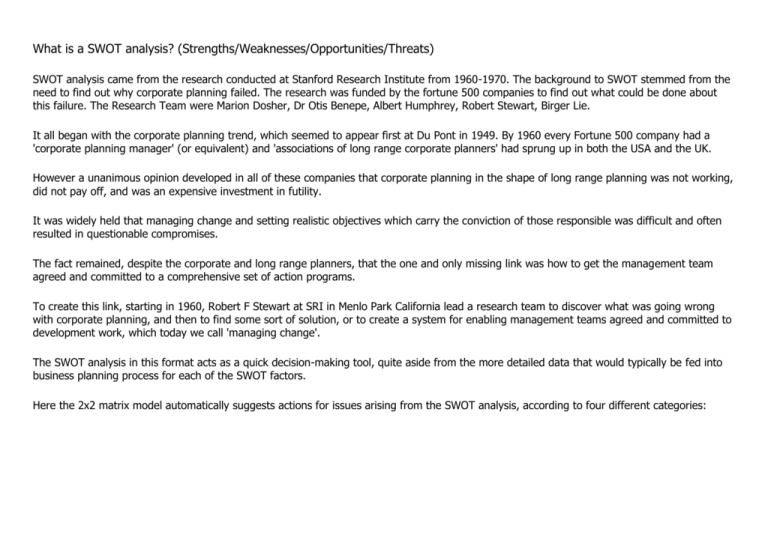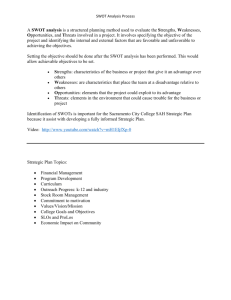File
advertisement

What is a SWOT analysis? (Strengths/Weaknesses/Opportunities/Threats) SWOT analysis came from the research conducted at Stanford Research Institute from 1960-1970. The background to SWOT stemmed from the need to find out why corporate planning failed. The research was funded by the fortune 500 companies to find out what could be done about this failure. The Research Team were Marion Dosher, Dr Otis Benepe, Albert Humphrey, Robert Stewart, Birger Lie. It all began with the corporate planning trend, which seemed to appear first at Du Pont in 1949. By 1960 every Fortune 500 company had a 'corporate planning manager' (or equivalent) and 'associations of long range corporate planners' had sprung up in both the USA and the UK. However a unanimous opinion developed in all of these companies that corporate planning in the shape of long range planning was not working, did not pay off, and was an expensive investment in futility. It was widely held that managing change and setting realistic objectives which carry the conviction of those responsible was difficult and often resulted in questionable compromises. The fact remained, despite the corporate and long range planners, that the one and only missing link was how to get the management team agreed and committed to a comprehensive set of action programs. To create this link, starting in 1960, Robert F Stewart at SRI in Menlo Park California lead a research team to discover what was going wrong with corporate planning, and then to find some sort of solution, or to create a system for enabling management teams agreed and committed to development work, which today we call 'managing change'. The SWOT analysis in this format acts as a quick decision-making tool, quite aside from the more detailed data that would typically be fed into business planning process for each of the SWOT factors. Here the 2x2 matrix model automatically suggests actions for issues arising from the SWOT analysis, according to four different categories: opportunities (external) threats (external) strengths (internal) weaknesses (internal) strengths/opportunities weaknesses/opportunities obvious natural priorities potentially attractive options Likely to produce greatest ROI (Return On Investment) Likely to produce good returns if capability and implementation are viable. Likely to be quickest and easiest to implement. Probably justifying immediate action-planning or feasibility study. Potentially more exciting and stimulating and rewarding than S/O due to change, challenge, surprise tactics, and benefits from addressing and achieving improvements. Executive question: "If we are not already looking at these areas and prioritising them, then why not?" Executive questions: "What's actually stopping us doing these things, provided they truly fit strategically and are realistic and substantial?" strengths/threats weaknesses/threats easy to defend and counter potentially high risk Only basic awareness, planning, and implementation required to meet these challenges. Assessment of risk crucial. Investment in these issues is generally safe and necessary. Executive question: "Are we properly informed and organized to deal with these issues, and are we certain there are no hidden surprises?" - and - "Since we are strong here, can any of these threats be turned into opportunities?" Where risk is low then we must ignore these issues and not be distracted by them. Where risk is high we must assess capability gaps and plan to defend/avert in very specific controlled ways. Executive question: "Have we accurately assessed the risks of these issues, and where the risks are high do we have specific controlled reliable plans to avoid/avert/defend?" SWOT Analysis Template Situation being analysed: _________________________________________________________________ This SWOT example is for your new business opportunity. Many criteria can apply to more than one quadrant. Identify criteria appropriate to your own SWOT situation. criteria examples Advantages of proposition? Capabilities? Competitive advantages? USP's (unique selling points)? Resources, Assets, People? Experience, knowledge, data? Financial reserves, likely returns? Marketing - reach, distribution, awareness? Innovative aspects? Location and geographical? Price, value, quality? Accreditations, qualifications, certifications? Processes, systems, IT, communications? Cultural, attitudinal, behavioural? Management cover, succession? Philosophy and values? criteria examples Market developments? Competitors' vulnerabilities? Industry or lifestyle trends? Technology development and innovation? Global influences? New markets, vertical, horizontal? Niche target markets? Geographical, export, import? New USP's? Tactics: eg, surprise, major contracts? Business and product development? Information and research? Partnerships, agencies, distribution? Volumes, production, economies? Seasonal, weather, fashion influences? strengths weaknesses criteria examples Disadvantages of proposition? Gaps in capabilities? Lack of competitive strength? Reputation, presence and reach? Financials? Own known vulnerabilities? Timescales, deadlines and pressures? Cash flow, start-up cash-drain? Continuity, supply chain robustness? Effects on core activities, distraction? Reliability of data, plan predictability? Morale, commitment, leadership? Accreditations, etc? Processes and systems, etc? Management cover, succession? opportunities threats criteria examples Political effects? Legislative effects? Environmental effects? IT developments? Competitor intentions - various? Market demand? New technologies, services, ideas? Vital contracts and partners? Sustaining internal capabilities? Obstacles faced? Insurmountable weaknesses? Loss of key staff? Sustainable financial backing? Economy - home, abroad? Seasonality, weather effects?






